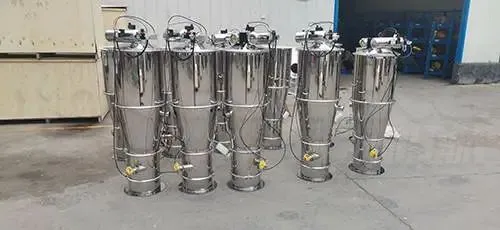They mainly move powder and granular materials. Examples include API powder, chemicals, metal oxides, and explosive powders. They also move capsules, tablets, pills, small food particles, and explosive particles. They cannot move very wet, sticky, or heavy materials.
Not all materials can be fed with vacuum feeders. To find out if materials can be moved, we must measure and analyze their key traits. Characteristic parameters include: stacking angle, stacking density, particle factor, electrostatic constant, moisture sensitivity, explosion risk, toxicity, and corrosiveness.

(1) Bulk density Bulk density refers to the weight of a material per unit volume in a loose state. Particles or powders contain material and air. So, their bulk density will change with stacking form. So, we must measure the bulk density in the actual state.
(2) The angle of accumulation is important. It judges how well a material flows. It is shown by the angle of accumulation. This is the angle between the cone formed by the material and the horizontal plane. The smaller the angle, the better the fluidity, and vice versa. However, for some materials, the accumulation angle is not a good measure of fluidity.
(3) Particle factors are key. They include weight, size range, shape, and hardness. They affect material fluidity and system design.
(4) Moisture sensitivity All materials have the characteristic of absorbing moisture. Moisture-sensitive materials may absorb moisture and clump. They may even stick to the pipe wall or filter, blocking them.
(5) Fine particles and air can mix to form an explosive mix. If a spark hits, an explosion may occur. There are three necessary conditions for dust explosion: oxygen, critical concentration, and sparks. It is hard to control material concentration during transportation. But, you can control oxygen and sparks. Inert gas can control the risk of explosion. It isolates oxygen. Avoid sparks by eliminating static electricity.
(6) Toxicity The leakage of toxic powders will cause environmental pollution and personal injury. Reliable technology and equipment must be used to avoid this during transportation. Vacuum feeders are safe. The pressure inside them is lower than atmospheric pressure. So, there will be no leaks. Also, the conveying system must treat the gas. It must do so to make it harmless and to meet emission standards.
(7) Some powders are very corrosive. It is necessary to select suitable materials to make vacuum feeders.
